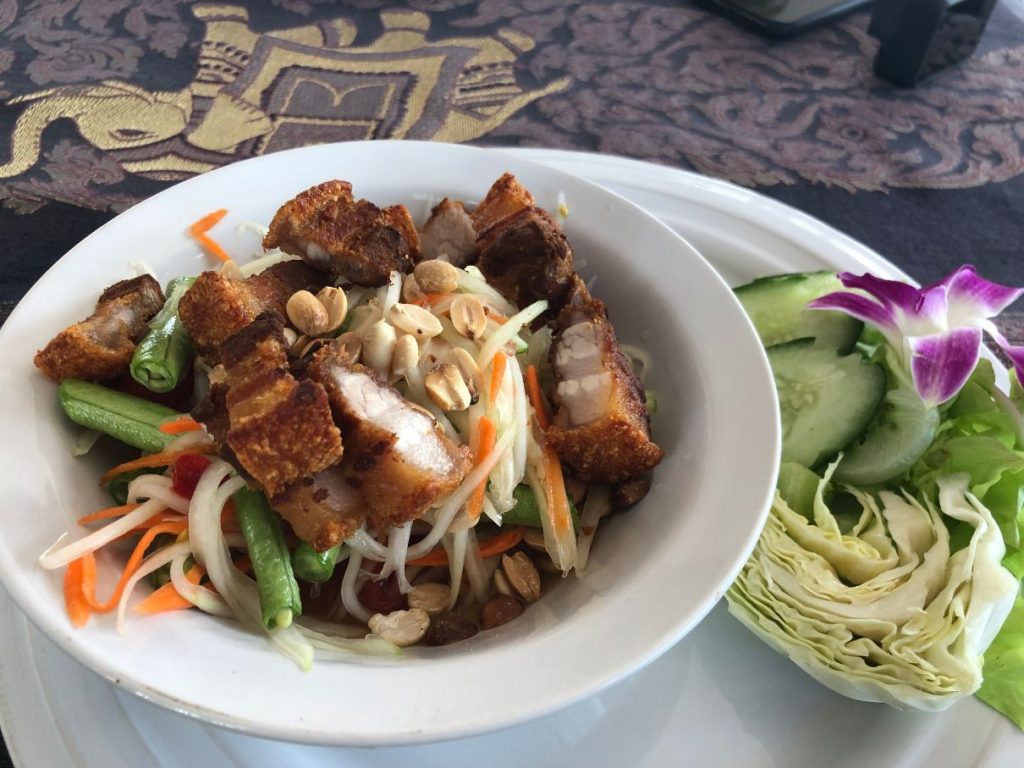Green papaya salad, a dish that has garnered worldwide acclaim, is more than just a culinary delight. Known as Som Tam in Thailand, this dish offers a perfect symphony of sour, sweet, and spicy flavors, becoming a staple in the cuisine of not just Thailand, but also Laos, Cambodia, and Vietnam. Its rich history, unique preparation method, and fascinating variations make it a truly captivating subject for food enthusiasts.
The roots of green papaya salad trace back to the ethnic Lao people, who are spread across Thailand, Laos, Cambodia, and Vietnam. This dish is a testament to their ingenious culinary approach of not letting any part of the fruit tree go to waste. The use of green, unripe papaya in the salad is believed to have started this way, giving birth to a dish that would eventually charm taste buds across the globe.
The method of preparation is another aspect that makes green papaya salad an intriguing dish. Traditionally, the salad is prepared in a mortar, with the ingredients being pounded together to release their flavors. This method is so iconic that in Thailand, the dish is often referred to as ‘pok pok’, mimicking the sound of the pestle hitting the mortar. This technique not only blends the ingredients perfectly but also lends the salad a unique texture that adds to its overall appeal.
At its heart, the green papaya salad is a simple dish. Its basic version contains shredded green papaya, chili, garlic, cherry tomatoes, long beans, lime juice, fish sauce, and palm sugar. The vibrant ingredients, each contributing to the dish’s complex flavor profile, are a testament to the culinary richness of Southeast Asia.
While the basic green papaya salad is a delight in itself, the true beauty of this dish lies in its numerous varieties. Each region adds its own twist to the salad, creating versions that are as diverse as they are delicious.
In Thailand, for instance, you’ll find Som Tam Thai, which includes peanuts and dried shrimp, adding a delightful crunch and umami flavor to the salad. In Laos, the salad, known as Tam Som or Tam Mak Hoong, often includes fermented fish sauce and crab, lending a uniquely tangy and savory taste.
Cambodia’s version of the salad, Bok L’hong, includes salted preserved tiny crabs and often omits fish sauce, resulting in a more pungent flavor. Meanwhile, in Vietnam, the salad, called Goi Du Du, is often sweeter and includes aromatic basil and beef jerky, creating a fascinating blend of flavors.
Each of these varieties adds a unique dimension to the green papaya salad, making each version an adventure in itself. No matter which version of green papaya salad you try, it promises to be a flavorful journey through Southeast Asian cuisine, offering a sensory experience that’s hard to forget.
Green Papaya Salad (Som Tum)
It's a spicy but also refreshing salad that I absolutely love. When in Thailand make sure you tell your waiter you don't want it spicy. It will still be spicy for most people, but Thai serves it even more spicy for locals. When making at home obviously you can choose how much spicy ingredients you add to it.
Ingredients:
Instructions
-
Place shredded papaya in a bowl with water and ice cubes and leave it there for about 10-15 minutes
-
Drain papaya and dry it well on paper towel
-
In a large mortar and pestle pound garlic and chilies, then add halved green beans, dried shrimp, and peanuts.
-
Add fish sauce, tamarind sauce and lime juice and mix well using a spoon.
You can replace tamarind sauce with ketchup -
Add halved tomatoes and papaya.
-
Pound with pestle, turn and pound again. Continue until well mixed and tomatoes are just a bit crushed.
-
Transfer salad and juice from mortar to the plate or bowl and sprinkle with some peanuts.
-
Can be served with set of side dishes. Most often it's sticky rice or crispy pork.
Nutrition Facts
Servings 1
- Amount Per Serving
- Calories 270kcal
- % Daily Value *
- Total Fat 12g19%
- Saturated Fat 10g50%
- Sodium 34mg2%
- Total Carbohydrate 44g15%
- Dietary Fiber 6g24%
- Sugars 25g
- Protein 5g10%
* Percent Daily Values are based on a 2,000 calorie diet. Your daily value may be higher or lower depending on your calorie needs.


Leave a Reply